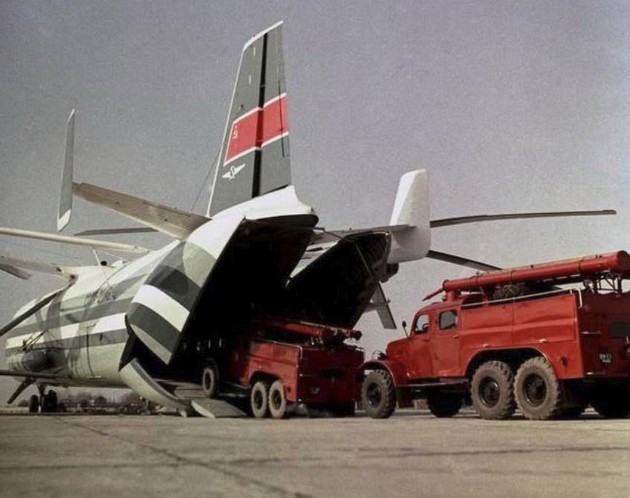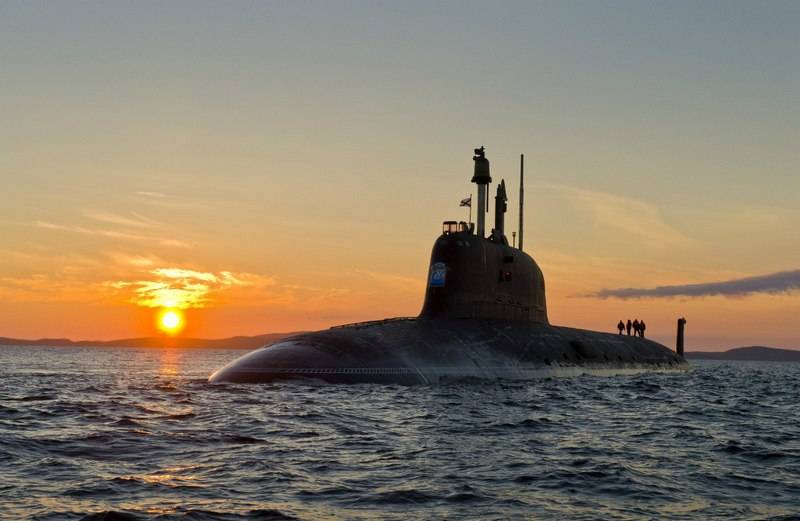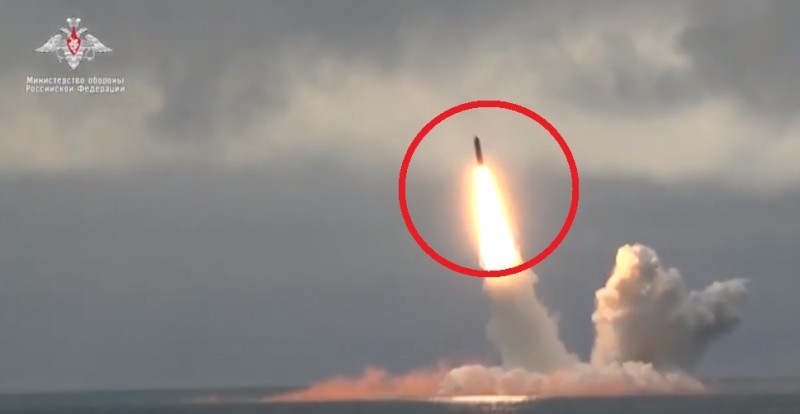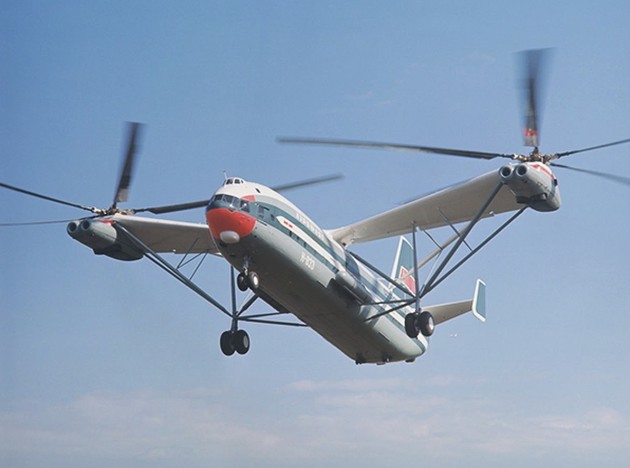
In connection with the needs of the economy and the armed forces in the transportation of cargo weighing more cohesive 20 t. in OKB. M. L. Mile in 1959. began studies of superheavy helicopter, and in 1961. The State Committee for Aviation Technology has given the task of designing a helicopter lifting capacity 20-25t. In May 1962,. It came out of the USSR Council of Ministers on the development of the Mi-12 heavy-lift transport helicopter and (AT 12), capable of carrying various types of military vehicles weighing up to 25t, including the latest strategic missiles.
The Mi-12 – video
After investigating various schemes helicopters: single screw with four GTE D-25B and CCD drive system from the low-speed turbines, twin-screw and twin-screw longitudinal transverse schemes - a decision was made to develop a twin-screw helicopter transverse scheme using rotors Mi-6 and twice the power plant and transmission and based on the experience of development twinscrew helicopters G-3, G-4 and G-11 and the transverse scheme EDO. P. Bratuhina. Helicopter was proposed to use a reverse narrowing of the wing, reducing the loss of thrust rotor, circuit which has been recognized by the present invention and patented. dynamically similar model was developed to study the stiffness and frequency characteristics of unusual bearing system, tested in TsAGI, where in wind tunnels conducted purging helicopter models. a full-scale test stand was also built for the finishing of the bearing system, powerplant and Gearing. Developing helicopter heading M. L. Miles and its substituents H. D. Rusanovich and M. n. Tishchenko.
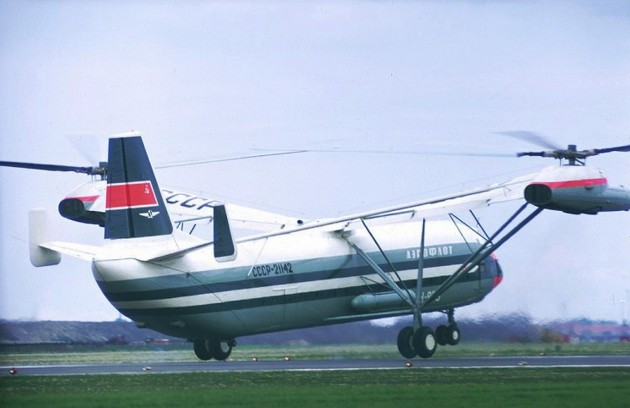
In April 1965 g. came the Council of Ministers Resolution on the construction of the first prototype of the helicopter on the EDO factory, and the pre-production of the first series of five helicopters was launched at the Saratov Aviation Plant. At the end of 1965. It was made the layout of the helicopter and demonstrated the possibility of accommodating the most types of heavy military equipment, and in April 1966. It began assembling the first prototype of the helicopter, completed in the summer of 1967.
First Flight Mi-12 (AT 12) took 10 July 1968 of the year (Test Pilot In. P. Koloshenko), and the fall of the helicopter was transferred to the Flight Research Institute for public testing, during which 22 February 1969. crew. P. Koloshenko set a world record 31T lifting to a height of 2350m, a 6 August 1969. the absolute world record 40t lifting has been set to a height of 2250m, not surpassed hitherto; only B-12 helicopter has been established 8 world records. In 1971. Helicopter V-12 was successfully demonstrated at the 29th International Air Show in Paris, where he was recognized “star” salon, and then in Copenhagen and Berlin.
The second prototype of the Mi-12 helicopter (AT 12) It made its first flight 28 May 1973. (Test Pilot T. AT. Alferov). By this time there is no need in the military helicopter carrying capacity through the creation of a more efficient and lighter strategic missiles on mobile launchers, and all the needs of the economy and the armed forces have successfully met Mi-6 and Mi-10, so the development of the B-12 has been discontinued, and the first experimental helicopter was handed over to the Air Force Museum in Monino.
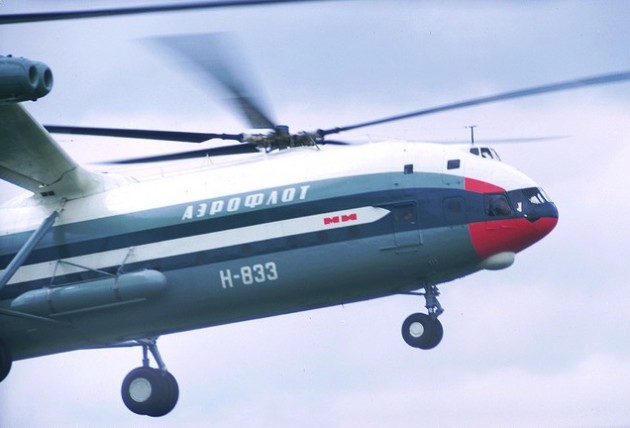
The Design Bureau investigated a number of super-heavy helicopter project, is the development of the Mi-12 carrying capacity 40 - 50t and intended for the carriage of one-piece of economic goods and to transport intercontinental ballistic missiles:
- Mi-12M - the development of the B-12 to transport cargo weighing 40 tons at 200 km with two GTE D-303 with a capacity of 20000l.s. and six-bladed rotors;
- B-16 - with a maximum capacity of 50 t with two powerful CCD with low-speed and six-bladed turbine rotors.
The project also studied-16 three-screw scheme with six D-GTE 25VF, but its further development and other projects was deemed inappropriate due to the termination of the Mi-12 program.
Design
Helicopter formed by twin-screw scheme with four GTE and tricycle landing gear.
Fuselage semi-monocoque structure has a cargo compartment, like the AN-22, size 28.15 x 4.4 x 4.4m with rear cargo door with a falling ladder and side doors and electric winch and hoists for loading various equipment. The cabin could accommodate 196 the soldiers or 158 wounded on stretchers. Cabin crew duplex, two pilot placed lower cabin, flight engineer and bortelektrik, at the top - the navigator and radio operator.
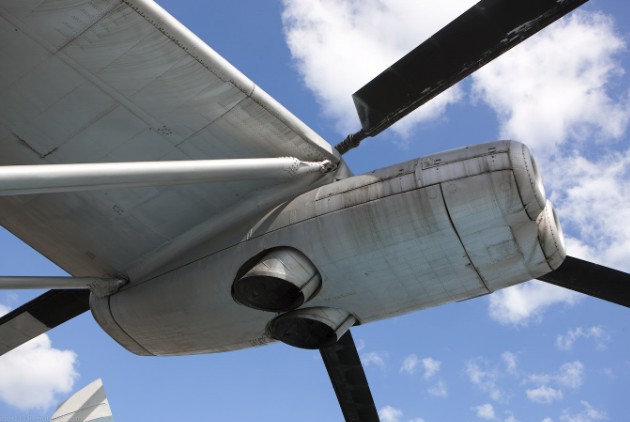
wing verhneraspolozhennoe, span 28.4m, different reverse delta (the end of the chord twice Root) and large cross V (-), supported truss braces, connected to the fuselage and the undercarriage legs.
The plumage of the aircraft type, c Bolshoi carpet, with rudder and stabilizer, with elevators and endplate.
chassis tricycle, fixed landing, with dual wheels on all supports and shock absorbers pnevmomaslyannymi. Track chassis 13.1m, base 12.9m, on the fuselage in front of the ramp of the cargo hatch has additional support, used when loading a helicopter.
Five-bladed rotors, They have the same construction, how MI6, and arranged with a minimum overlap of ~ 3m, all-metal blades of Ni-6 were replaced with new blades composite structure with steel spar, GRP nose portion and the rear sections of honeycomb core with a foiled.
The power plant consists of four uprated GTD D-25VF, specially designed by OKB chief designer P. D. Solovyov. Engines are arranged in pairs in nacelles on the wing tips.
The fuel system includes the main fuel tanks in the wings and external fuel tanks.
The transmission system is very complex, motors with reduction gears and the intermediate gear in the center section and transmission shafts for synchronization and transmission power in the event of failure of one or even two motors on the one hand.
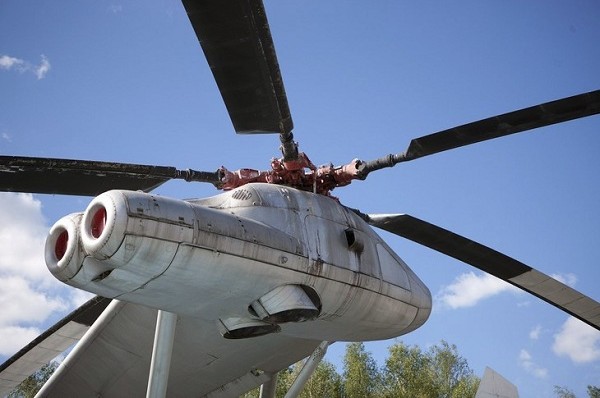
Control system with a two-stage main and intermediate hydraulic actuators, It characterized great length and includes apparatus for automatic load control. types of control schemes for cross helicopters: longitudinal control is performed while changing the cyclic pitch of both screws and their inclination, track - Differential pitch changing and tilt in different directions; cross - differential collective pitch control screws. Management of collective pitch rotor is synchronized with the control of the elevators, and the deviation of the rudder improves the efficiency of directional control. Helicopter was specially designed AP-44 autopilot, complete with autopilot AP-34B-1.
Eight world records and almost thirty years of neglect – is a short biography of the biggest and most-lift helicopter in the world Mi-12. giant helicopter, the family of the last helicopters, created by General Designer Mikhail Mil Leontyevich, It incorporates a number of original design of new products and technical solutions, which were later successfully applied on many planes and helicopters. About, Birth of this car, tell her daughter Hope and chief designer Elena Miles. Together with other members fund M. L. Mile they seek to preserve the memory of the founders of Russian helicopters.
“…The spectacle of the Mi-12, majestically floating above Le Bourget at a surprisingly low noise level, despite its power 26000l.s, hidden in the motor gondola, makes me think: do almost all helicopter went the wrong way about two decades”.
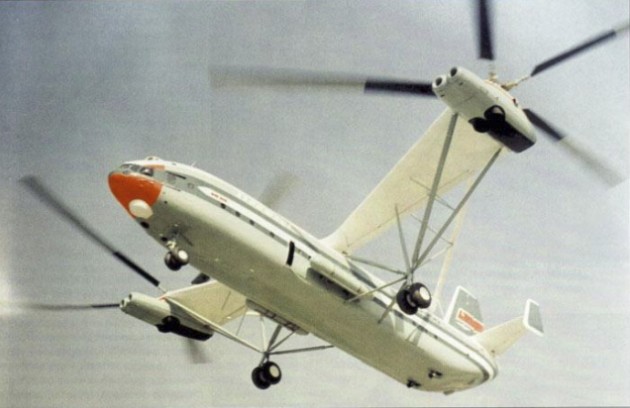
“…The debut of Russian transport helicopter giant Mi-12, undoubtedly, I stirred the helicopter around the world… Operating organizations discuss, arose after his show to the general public, eg, anyone outside the Soviet Union, it may be necessary to operate such a huge machine”.
“…One of the representatives of the company “Sikorski”, affected the weight of the helicopter, He stated, that the development of such a machine in the US would cost 200 millions of dollars, It is inconceivable”.
These were the remarks of the French and international press after the demonstration flight of the Soviet helicopter giant B-12 at the International Aviation and Space Show in Le Bourget near Paris in June 1971 of the year. This and still the world's largest rotorcraft wingspan with two rotors reached 67 m, screw diameter – 35 m, fuselage length – 37 m, height – 4,4 m, diameter gear wheel – 1,7 m, maximum weight – 105 tonnes. He impressed everyone not only for its unprecedented size, but also new design solutions, that have been evaluated as the most advanced achievements of aviation science and technology.
The Mi-12 design Michael Mil first took to the sky in spring 1967 of the year. In a short time on this machine was installed 8 world records. Chief among them – carrying capacity record: at 1969 The 12-year climb to an altitude 2250 meters of cargo weight 44 205 tons. This achievement is recorded in the Guinness Book of Records, and for thirty years remains unmatched.
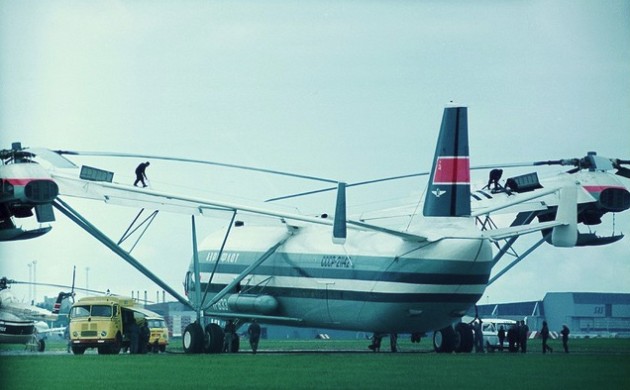
Heavy transport helicopter was conceived in the early 1960s as one of the parts of the plan of conducting rapid nuclear war. He was supposed to deliver to the starting place in remote areas of missiles and large-sized cargoes. It was planned to transport them to the nearest airfield An-22 transport aircraft “Antaeus”, then loaded onto a helicopter fuselage with the same dimensions and cross to the place of dislocation. M. L. Miles wrote in his diary: “NATO's concept of the four-five-day nuclear war. All safety factors, including geographical remoteness, It is no longer active. Instead of this – constant mobility. Therefore, we need… powerful helicopter on one end of the field plane and the other”. This concept was developed in the United States. There were building a heavy helicopter company NLN “Boeing”, but he did not even take off.
By the development of the Mi-12 M. L. Miles started on the instructions of the Soviet government in 1963 year. The Experimental Design Bureau, which he led, It had already created several types of first-class helicopters, such, How I-1, I-4, I-6, I-8, I-10. They are all built on a single-rotor scheme (a main rotor on the fuselage). This design is for heavy machine designers of D. M. Kuznetsov and P. A. Solovyov considered inappropriate, because it was necessary for her to develop a heavy-duty gearbox and simultaneously solve other complex technical problems.
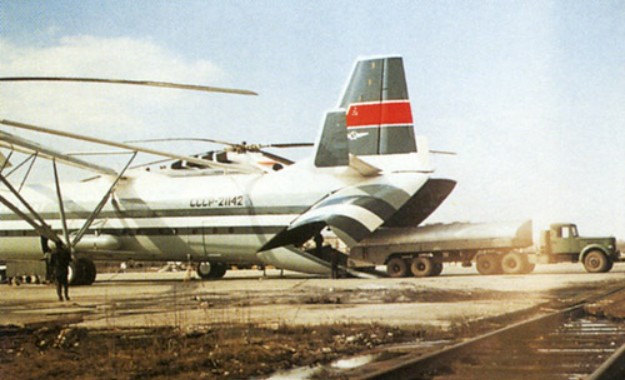
Miles was looking for a suitable circuit excruciatingly, I pondered the multiple options, I analyze each decision on all sides, taking into account all the circumstances, up to production conditions. considered, eg, single-rotor helicopter with jet engines on blade tips. The gearbox was not necessary for him, however, it required to design a new bearing rotor system, engine, other components and spare parts, simply put, create a new helicopter design. This option is also not suitable.
M. L. Miles wrote in his diary: “How to create the next, more by weight of the helicopter? Calculate the optimal design parameters are almost unable to – too many conflicting considerations should weigh Designer… Sooner or later, he was faced with the question of the expediency of the further increase in the diameter of the rotor and the transition to two- or mnogovintovuyu circuit… combinations, essentially, not so much: twin-screw (longitudinal or transverse scheme) and three-screw Helicopters”. Considered and even three-screw chetyrehvintovaya scheme, but both were rejected: analysis shows, that the necessary capacity (25 tonnes) can be achieved by two screws.
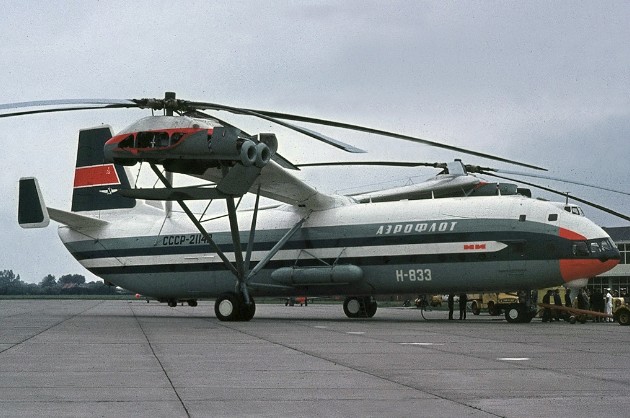
After selecting a scheme to decide, how to build “bridges”, connecting the rotors: transversely or longitudinally. Initially we decided to analyze the advantages and disadvantages of the longitudinal circuit, used on helicopters Soviet Yak-24 and V-44 American, that M. L. Miles gained on behalf of the Government during a trip to the United States in 1960 year. Three Yak-24 took the military, Imported from Torzhok to the test airfield in Panki, They began to fly and learn flight characteristics. We do this work test pilots. P. Koloshenko, R. AND. Kaprelyan and D. R. Karapetyan. During the tests, the non-uniform loading of the front and rear gearboxes have been found, large vibration, instability of the helicopter in flight. The same shortcomings manifested themselves at an American helicopter trial. After exhaustive analysis Miles finally stopped at the transverse Scheme. Helicopter this design even before the war was built in Germany, Heinrich Focke. His FW-61 was produced in series. We helicopters transverse scheme designed I.P.Bratuhin and NI Kamov.
Five years of work on the Mi-12 steel M. L. Mile for years the highest creative enthusiasm. “This machine is the best of, I was able to create, believe me”, – he said to his wife. The Design Bureau was a competition for the best design solution. It was attended by, one side, A. FROM. Braverman and A. M. Block, with another – M. L. miles, ABOUT. P. Bach and other young designers. Work began on the draft design. The first step is drawn farm, at its ends positioned engines. The difficulty was that, to avoid unwanted oscillations, inherent transverse Scheme, and dangerous resonant vibrations, that could cause suspended at the ends of farm engines.
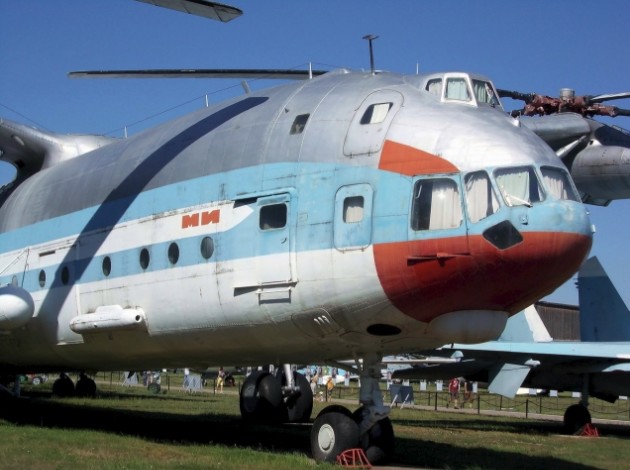
After working several variants was made the brilliant decision: make power plants on farms in the spatial side of the fuselage, part of their supporting struts to transform the so-called reverse delta wings – bottlenecks in the fuselage, wherein airflow from the rotor maximal, and expanding the end, engines where placed and the flow rate is minimal. The gain in lifting force reached 5 tonnes. In this circuit absolutely original patents have been obtained in England, in France and in Italy.
M. L. Mile had to prove the correctness of his choice in the higher court and get an opportunity to work on. Decisions are taken by a special commission headed by the head of TsAGI, The famous designer of aircraft. M. Myasishchev. 21 January 1965 Year Miles writes in his diary: “Yesterday there was a conference with glitter in punk. My report all liked. They were from the Central Red'kin, Maksimov, the entire apparatus of the Council of Ministers, Pışnov BBC, Total 450 human. I made Vildgrube, he groaning Mi-12, He said, what, without changing the load, it was possible to make a machine in the longitudinal half the weight of the scheme. We decided to beat him. We made Tishenko, Nekrasov, Radin and I. Re-made Vildgrube, it had to be seen”. Across 5 days of the new Blog Entry: “Already a week almost every day in the morning comes to us for half a day the head of TsAGI Myasischev with his assistants (8 human). Together with Fedulova Vildgrube and they understand my new scheme, comparing it with the longitudinal. And we, of course, We linger in the evenings. Today it is almost the final victory. Myasishtev for us… the day after the Commission. Instead of being twice as worse, our car is twice as good as the longitudinal, and indeed a great solution”.
Everything ends, In that. M. Myasishtev, and the Minister of Aviation Industry P. AT. Dementiev supported Mile. According to the government decision on the plant launched a project.
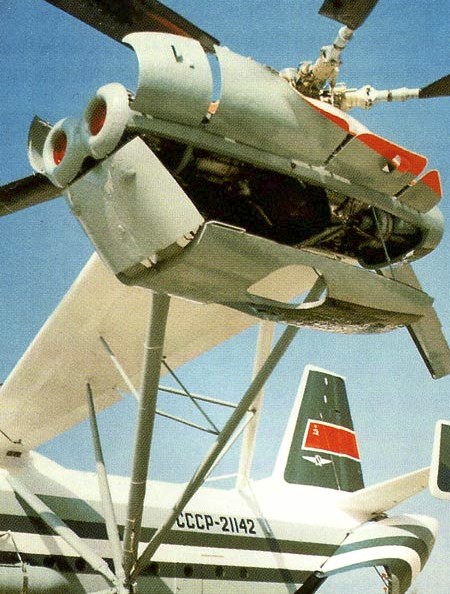
the wing of the Mi-12 truss console
Very interesting was the design for engine nacelles. Folding hood allows service engines without additional ground ladders. It was possible to get out of the cab, pass on the wing, get on the gondola hood is lifted, how to trap, and start the engine. Later this arrangement and applied to Ni-26. Four GTD-25VF structure P. A. Solovyov, power 6500 l. from. each, They work in pairs, transmitting rotation of two of the main gearbox, on the output shaft of which five-bladed rotors were installed. engines, main gearboxes, the sleeve and the swash plate have been produced from commercially-6 Mi-10 and Mi, but we do not just put them on the Mi-12, and thoroughly improved: the engine began to 1000 l. from. more powerful, each blade is facilitated in 300 kilograms, a new spar.
That the screws have not clashed, and that the blades project went on for one another 1.5 m, it was necessary to achieve absolute synchronicity of their rotation. To this end, we developed a special transmission shaft, connecting the main gears. On the fracture of the shaft at the site of the wings joining the intermediate gear set. Synchronous shaft serving to transmit power from one engine to another.
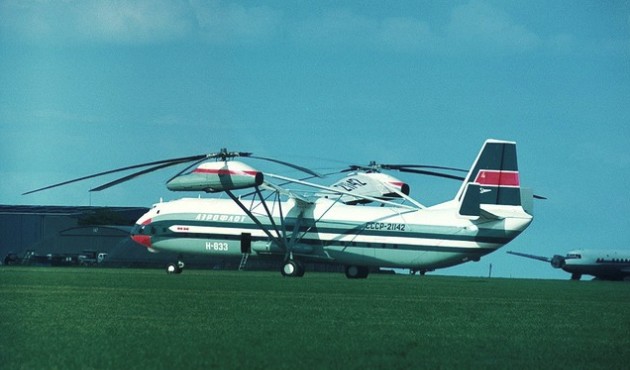
An important question for the helicopter lateral scheme – The direction of rotation of screws. Back in 1930-1940's M. L. Miles dealt with problems balancing and handling of gyroplanes and aircraft, and was recognized as one of the leading aerodynamics. He succeeded with the help of simple devices to significantly improve aircraft control system IL-2, IL-4, IL-16, La-5 and Tu-2. Mil developed in those years, the theory is still used in the design of aircraft control systems.
In work on the Mi-12, General Designer had to recall his old job at handling. He considered the aerodynamic forces and moments, acting on the helicopter when rotating screws in two directions: outwardly from the fuselage – so-called type “brass” and in the opposite type _ “butterfly”. Miles concluded, that in case the rotation scheme of screws “brass” Helicopter more manageable, although many experts strongly encouraged him to choose the screw rotation direction from the outside to the fuselage. Despite the successful flights of a helicopter, M. L. Mile did not manage to convince the opponents of the correctness. Nevertheless the factory, this work was appreciated and considered open.
By studying stability and balancing helicopter, General Designer convinced, during rotation of the screw according to the scheme “brass”, that is, from the fuselage, control efficiency at the time of roll increases. If the screw is rotated in the opposite direction, then on a roll can be such conditions, in which management refuses. Pilot to stop deflects the handle to the right, fully “squeezes” pedal, and the car, fulfilling spiral, still it topples over the left wing.
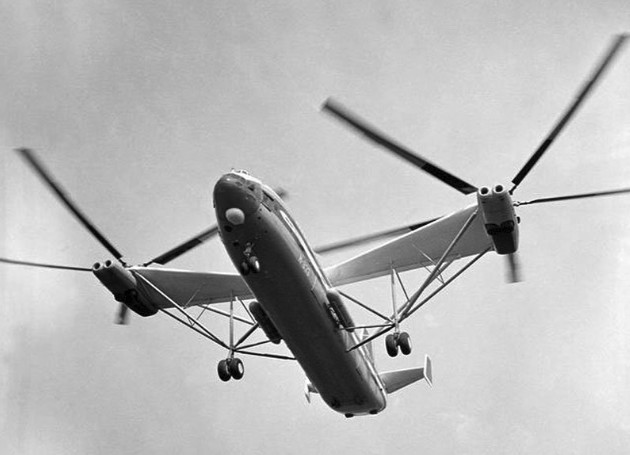
The flights have shown very good handling and stability of the Mi-12. In its pilot piloting. P. Koloshenko told, that the helicopter was flying steadily with the control stick thrown from three to seven minutes. He remembered and unusual sensations for helicopter pilot: It was not flashing before the eyes of the propeller blades, vibration and noise: “I like sailing on a huge ship”. And all this thanks to the fact, that engines removed from the cockpit and the number of revolutions of the rotors is less than three times, than other helicopters.
Built helicopter was decided to turn into a test model to check on it every possible unwanted vibrations. Instead of the blades on the hub put vibrators – electric motors with an unbalanced load, and to simulate flight conditions, suspended helicopter depreciation cords. Its packed with research equipment. Tests were conducted at night, and in the afternoon we treated the information. This went on for a month. During lapping machine Michael L. signed numerous instruments and test reports, confirming its readiness for flight. He said: “I want to bear the full responsibility”.
At the same time M. L. Miles in collaboration with young designers A. AT. Nekrasov, A. FROM. Braverman, L. n. Grodko and M. A. Leykandom wrote and published a book “Helicopters. Calculation and Design”, which is considered the main work of his life. It compiled and analyzed a huge helicopter engineering experience in the design office headed by him and traced the entire history of the helicopter from the beginning of the 20s.
Salon Mi-12
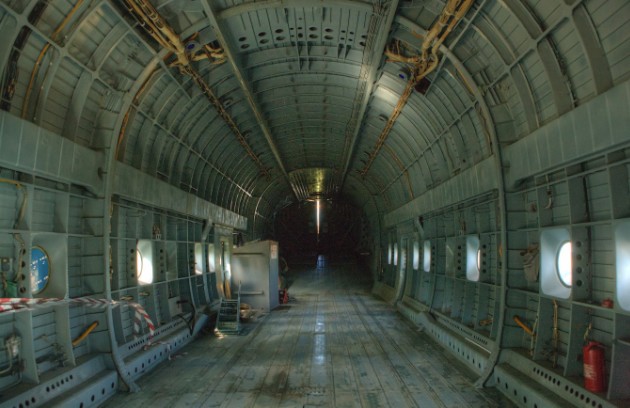
spring 1967 year to see the first flight of the Mi-12 in the original flight test facility was attended by the creators of the helicopter, representatives of the Research Institute, factories and related businesses, Ministry of Aviation Industry, military. Under the march aviators “we are born, make fairy tale come true” powerful tractor pulled the helicopter out of the shop. He could not turn around there and traveled tail first. Someone said, quietly: “Bad sign”. Michael L. heard it and frowned, He was superstitious. The pilot. P. Koloshenko turned the helicopter into the wind, He steers right, _ left the car listening. Then he began to increase the engine speed, in preparation for the start. Finally, helicopter pulled away smoothly from the ground and hung. And suddenly the car danced, slowly began to rock from side to side, then tipped and, without being subject to the control handle, so skewed and went down. As the helicopter touched the ground, tires were bent on one side of the wheel and hit the concrete rim. One of them broke, and with a loud bang the camera snapped… So many hopes were dashed!
Very soon after the failure of contracted Miles, and a control system deficiencies B-12, found after the accident, corrected without, although regularly and extensively reported about all General and received in response to guidance and advice.
Finally, it was day, when they decided to lift the car into the air again. Again, many people had gathered, I arrived and Michael L.. At this time the flight was successful, Though pulled from the helicopter hangar, like the first time, tail first. Hulk vicinity of vesom 100 tons up with surprising ease, in the sky, it was very beautiful. Accompanied by two Mi-10 helicopter is flown on the test airfield, where he made more than a hundred flights. All planned tests have been completed, preparations began for a new machine for serial production.
Cabin Mi-12
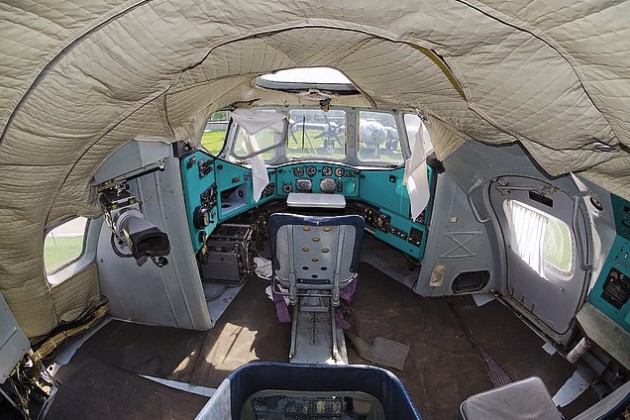
At Mi-12 had no competitors. Powerful Mi-10K (or B-10), Sikorsky S-64-F, Boeing-Vertol SN-47S “Chinook” lift loads 11-15 tonnes. For success in the creation of load-lifting helicopter M Design Bureau. L. Mil was awarded established by the American Helicopter Association second international prize named after Igor Sikorsky. The son of a prominent aircraft designer, a representative of his company in Europe, Sergei Sikorski wrote: “Before engineering achievement, What is B-12 helicopter, You can only take your hat… This helicopter is the only one of its kind and will be used to perform unique operations. I am referring to the expedition in the Arctic regions or search for oil fields. The helicopter will replace the railroad there, which still has not gone before”.
Despite all the achievements and the highest rating, machine in the series did not go. Military, namely, they staked, abandoned the Mi-12 – before them there were already other strategic objectives. M. L. supposed miles, what, in addition to military purposes, helicopter can hardly find application, Although not rule out its use for transportation of oversized cargo, such as oil platforms or welded at the factory pipeline lashes. However, such rare unique operations could be carried out by two or three smaller duty helicopters. Organize the production of the Mi-12 was too expensive pleasure. Since, almost 30 years, the largest and most-lift helicopter in the world stands on the eternal docked in the Aviation and Space Museum in Monino near Moscow.
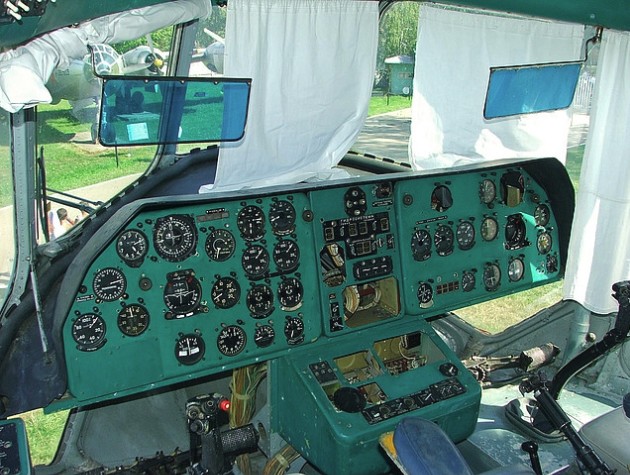
Performance characteristics of the Mi-12
– First flight: 10 July 1968 of the year
– Total built: 2
Mi-12 crew
– 6 human
Capacity of the Mi-12
– 196 passenger
Carrying capacity of the Mi-12
– 44 205 tons
Overall dimensions of the Mi-12
– The diameter of the rotor: 2 x 35,00 m
– fuselage length: 37,00 m
– The height of the rotating screws: 12,50 m
All Mi-12
– empty weight: 69 100 kg
– normal takeoff: 97 000 kg
– Maximum takeoff: 105 000 kg
Motors Mi-12
– engine's type: 4 × D GTD-25VF
– Power: 6497(one) l. from.
Mi-12 speed
– Cruising speed: 240 kmh
– full speed: 260 kmh
Range of flight Mi-12
– 1000 km
Practical ceiling Mi-12
– 3500 m
Photo Mi-12
